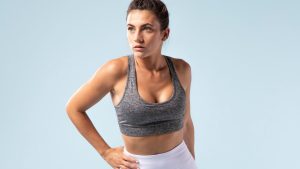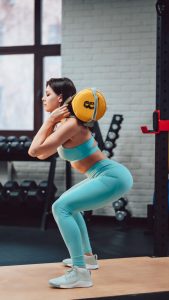Understanding the Benefits of Squats

Strengthening Muscles and Joints
Squats are a powerhouse exercise known for engaging multiple muscle groups simultaneously. For young athletes, this translates to enhanced lower body strength, crucial for various sports like soccer, basketball, track and field, and more. By targeting muscles in the legs, hips, and core, squats can contribute significantly to overall strength and stability.
Boosting Speed and Power
A key advantage of squats lies in their ability to enhance explosiveness and power. As young athletes undergo physical development, incorporating squats into their training regimen can aid in improving sprinting speed, vertical jump height, and agility, key components across numerous sports disciplines.
Considerations for 15-Year-Old Female Athletes
Proper Form and Technique
While squats offer numerous benefits, correct form and technique are paramount, especially for young athletes whose bodies are still developing. Incorrect execution can lead to injuries, particularly in the knees, lower back, or hips. It’s crucial to have qualified supervision and guidance to ensure proper form and minimize the risk of injury.
Individualized Training Programs
Each athlete is unique, with varying levels of fitness, strength, and development. Tailoring training programs to suit individual needs and abilities is essential. Consulting with coaches, trainers, or healthcare professionals can help design a well-rounded program that incorporates squats safely and effectively.
Impact on Sports Performance
Improved Athletic Performance
When implemented correctly, squats can contribute significantly to improving sports performance. By strengthening key muscle groups and enhancing power and speed, young athletes may experience an edge in their chosen sports, leading to better overall performance on the field or court.
Long-Term Development
Integrating squats into a comprehensive training regimen can yield long-term benefits beyond immediate performance enhancements. Building a strong foundation during adolescence can set the stage for continued growth, progress, and injury prevention as these athletes advance in their sporting careers.

So.
In essence, incorporating squats into the training routine of 15-year-old female athletes can indeed positively impact their sports performance. However, it’s crucial to approach this exercise with caution, emphasizing proper technique and individualized training programs. With the right guidance and focus, squats can be a valuable addition to a young athlete’s journey towards achieving their athletic goals.
Delving Deeper: The Role of Squats in Developing Athletic Potential
In the quest for athletic prowess, the inclusion of squats in a 15-year-old female athlete’s regimen demands a closer examination. Let’s further explore the nuances and additional considerations surrounding this pivotal exercise.
Addressing Potential Concerns
Growth and Injury Risks
One of the prevailing concerns regarding young athletes performing squats pertains to the impact on growth plates and the potential for injury. Contrary to misconceptions, when executed with proper form and under suitable supervision, squats are not inherently detrimental to growth plates. However, excessive weight or improper technique can pose risks. Hence, emphasizing controlled movements and gradually increasing intensity is crucial.
Psychological and Emotional Aspects
Training at a young age involves more than physical development it encompasses mental and emotional aspects as well. Pressure to excel, concerns about body image, and balancing training with other aspects of life can affect young athletes. Creating a supportive environment that encourages healthy training habits while addressing mental well-being is imperative.
Integrating Squats: Training Strategies
Progressive Overload and Periodization
A structured approach to training, incorporating progressive overload and periodization, is vital for young athletes. Gradually increasing intensity, volume, and complexity while allowing for adequate rest and recovery is key. This approach ensures continual improvement without overstressing the body.
Holistic Training Approach
Squats should be part of a holistic training regimen that encompasses various facets, including mobility, flexibility, agility, and core stability. By diversifying workouts, athletes can mitigate overuse injuries and develop a well-rounded skill set conducive to overall performance enhancement.
Beyond Physical Performance: Transferable Skills
Discipline and Goal Setting
Engaging in a consistent training routine that includes squats fosters discipline and goal-setting skills in young athletes. Setting targets for strength improvement or mastering proper form cultivates dedication and perseverance attributes valuable not only in sports but in life.
Teamwork and Leadership
In many sports, teamwork and leadership skills are as vital as physical abilities. Training sessions that involve partner workouts or group exercises, including squats, encourage camaraderie, communication, and leadership development among young athletes.
Conclusion: Squats as a Component of Athletic Growth
In the context of 15-year-old female athletes aiming for enhanced sports performance, squats stand as a valuable component in a holistic training approach. When approached conscientiously, considering physical development, psychological well-being, and training strategies, squats can contribute significantly to the overall growth and performance of young athletes.
In the pursuit of excellence, it’s crucial to strike a balance between pushing boundaries and prioritizing safety and holistic development.
External Links for Further Reading:
KidsHealth: Strength Training – Learn about safe strength training for teens.
Science Daily: Youth Sports Injuries – Insights into preventing youth sports injuries.
Sports Health: Female Athlete Triad – Understand the importance of nutrition and overall health in female athletes.
American Council on Exercise: Proper Squat Technique – Explore correct squat form and variations.
PubMed Central: Strength Training in Youth Athletes – Learn about the benefits and considerations of strength training in youth athletes.
National Strength and Conditioning Association: Youth Resistance Training – Discover insights into resistance training for young athletes.
Feel free to explore these resources for a more comprehensive understanding of youth strength training and injury prevention in sports! If there’s anything specific you’d like to know or discuss further, don’t hesitate to ask.
Comparison tabular
Here’s a comparative table summarizing the key aspects of utilizing squats for 15-year-old female athletes:
| Aspect | Benefits | Considerations |
|---|---|---|
| Physical Development | Strengthens lower body muscles and joints | Emphasize proper form and technique |
| Performance Enhancement | Boosts speed, power, and agility | Tailor training programs to individual needs |
| Potential Concerns | Minimal risk to growth plates if executed correctly | Psychological well-being is essential |
| Training Strategies | Implement progressive overload and periodization | Holistic training approach for diverse skill set |
| Transferable Skills | Fosters discipline, goal-setting, and teamwork | Encourages leadership qualities |
| Conclusion | Squats aid in holistic athletic growth | Balance between pushing limits and safety |
This table provides a concise overview of the benefits, considerations, and broader impacts of incorporating squats into the training regimen of young female athletes. If you need further details or have specific questions about any of these aspects, feel free to ask them down.
Wrapping up
In the realm of athletic development for 15-year-old female athletes, squats serve as a potent tool when wielded with care and consideration. They offer a gateway to not only physical prowess but also holistic growth, instilling discipline, teamwork, and goal-setting skills.
The essence lies in balance balancing the physical gains with the need for proper form, balancing the pursuit of excellence with the preservation of mental well-being, and balancing the drive for improvement with a holistic approach to training.
Ultimately, squats, when integrated into a comprehensive training program, can unlock a young athlete’s potential, paving the way for a journey marked not just by athletic achievement but also by resilience, determination, and overall growth.
If you’re an athlete or someone guiding young athletes, remember: it’s not just about the squats; it’s about the journey, the learning, and the development that comes with it.
Stay committed, stay focused, and above all, stay mindful of the holistic nature of growth in the pursuit of athletic excellence.

Hey there, it’s Mike Rrsq, the Editor-in-Chief over at Jsquat.com, and I’m absolutely obsessed with all things squat fitness! I’ve been lucky enough to get some serious recognition for my work in this field. With a solid background in the fitness and wellness industry, I’ve been there right from the get-go, helping shape this website into what it is today.
You see, I’m not just the boss around here; I’m also a passionate contributor. I love sharing my insights through my articles, and trust me, they’re not your run-of-the-mill stuff. Each piece I write is a labor of love, filled with my expertise and real-world experience in the fitness universe. So, if you’re into fitness and looking for some inspiration, you’re in the right place!
Related Posts
- Is It Effective for Female Runners to Include Squats Twice a Week for Performance Enhancement
For female runners seeking to elevate their performance, the debate over the frequency of squats…
- Is incorporating isometric squats beneficial for improving running performance
Isometric squats, a form of exercise where you hold a position rather than moving through…
- Is Incorporating Squats Twice a Week Beneficial for Boosting Performance in Male Cyclists?
Cycling is a sport that demands not just lower body strength but also endurance and…
- Should Asian Squats Be Done by Female Beginners for Toning Thighs
Toning thighs is a fitness goal many women pursue, and Asian squats often surface as…
- Can lunge squats make female thighs bigger or tinner
Lunge squats can indeed influence the size and shape of female thighs, but the outcome…
- Are squats with tempo beneficial for enhancing athletic performance in 15-year-olds?
Strength training for young athletes is a topic that sparks curiosity and sometimes concern among…
- Should a 56-year-old female incorporate squats to relieve lower back pain
Squats can be beneficial for relieving lower back pain in a 56-year-old female, but it's…
- The top 3 effective squat patterns for injury prevention in 28-year-old female athletes?
When it comes to injury prevention for female athletes, selecting the right squat variations becomes…
